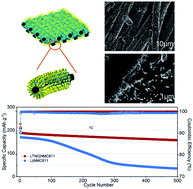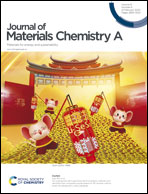Self-supported TiN nanorod array/carbon textile as a lithium host that induces dendrite-free lithium plating with high rates and long cycle life†
Abstract
Fabrication of a stable dendrite-free Li metal anode that accommodates very large volume changes is urgently needed for the development of advanced lithium metal batteries. Herein, an integrated Li/TiN/carbon textile anode (LTNC) is fabricated in which lithium is hosted in a self-supported TiN nanorod array with high surface area, excellent electrical conductivity, and porous structure. The as-prepared LTNC anode achieves outstanding electrochemical performance with a low overpotential of 50 mV and stable cycling for 1000 h at 1 mA cm−2, 1 mA h cm−2, and even at a high current density of 10 mA cm−2 it shows highly stable performance with a low overpotential. When paired with a LiNi0.8Mn0.1Co0.1O2 cathode, the assembled cells display enhanced capacity retention of 85% after 500 cycles at 1C and improved coulombic efficiency. Furthermore, a high capacity of 2.3 mA h cm−2 with a capacity retention of 92% is maintained at 1 mA cm−2 after 100 cycles when the negative to positive electrode capacity ratio is only ∼3.5. This work indicates that the structural engineering of Li metal is highly applicable for lithium metal batteries with high rates and long cycle life.



 Please wait while we load your content...
Please wait while we load your content...